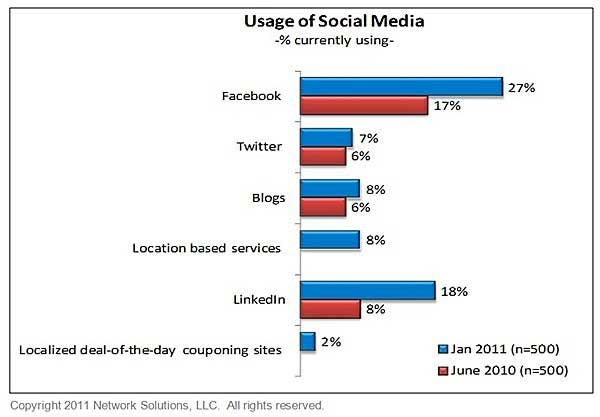Despite a lack of investment in marketing technologies and staffing over the past two years, many small businesses are now stepping up investments in digital channels such as social media, search, and online advertising, according to a survey from Network Solutions and the University of Maryland's Smith School of Business.
Websites are the cornerstone of digital marketing for small businesses (fewer than 100 employees), the study found: 56% of surveyed small-business owners say they have a website, up 10 percentage points (PPs) (or 21.7%) from the 46% that said so a year earlier.
Meanwhile, more small businesses are embracing social media and search to drive traffic to websites, according to the survey:
- 31% of small businesses now use some form of social media, up 7 PPs (29.2%) from the 24% that did so in December 2009.
- 27% have a search engine optimization plan, up 8 PPs (42.1%) from the 19% that did so in the previous year.

Below, other findings from the fifth wave of results from the Small Business Success Index, based on a survey of 500 small business owners.
Over the next two years, social media is expected to be the fastest growing marketing channel—with adoption levels increasing to 46%, up 15PPs (48.4%) from current levels.
Online advertising is also a key priority over the next two years:
- 54% of small businesses expect to use online ads in industry/public directories within two years, up 17 PPs (45.9%) from current levels.
- 30% of small businesses expect to use online display advertising, up 9 PPs (42.8%) from current levels.
Similarly, in two years, 36% of small businesses expect to have a search engine optimization plan, up 9PPs (33.3%) from current levels.
Social Media Channels
Among small businesses using social media, over one-quarter (27%) have presence on Facebook, up 10 PPs (58.8%) from six months earlier. The use of LinkedIn has more than doubled over the same period, from 8% in June 2010, to 18% in January 2011.

The Business Case for Social Media
Social media's role has changed over the past year: Engaging existing customers (63%) has taken on a more prominent one (up from 46% a year earlier) while attracting new customers (59%) via social media is slightly less important than in the previous year (61%).

Small businesses are increasingly benefiting from stronger collaboration via social technologies—both inside (31%) and outside (44%) the organization.
Looking for real, hard data that can help you match social media tools and tactics to your marketing goals? The State of Social Media Marketing, a 240-page original research report from MarketingProfs, gives you the inside scoop on how 5,140 marketing pros are using social media to create winning campaigns, measure ROI, and reach audiences in new and exciting ways.
Social Conversations Improving Loyalty
More than three in five (63%) small businesses using social media say using social channels has improved customer loyalty by enabling them to talk directly with customers, whereas 56% say social marketing has used up more time than expected.
Some 40% say social media has resulted in allowing people to criticize their business, up from 17% who said so a year earlier. Only 5% say social media has hurt more than helped the business image because of negative comments.
The Bottom Line
Looking at the past 12 months, 25% of small business owners say social media use has been profitable (vs. 22% who said so one year earlier), while 15% say they lost money (vs. 19% a year earlier), and 46% say it paid for itself (vs. 53% a year earlier).
Social Media via Mobile
Portable devices play a role in some small businesses' participation in social media:
- 47% of small business owners using social media say they have responded to comments on social media sites via mobile devices.
- 47% have used mobile devices to send text messages to customers.
- 36% have sent status updates via mobile device.
- 35% have reviewed social content for their business via mobile.
Mobile Marketing Still a New Frontier
Most small business owners are aware of various mobile marketing activities such as sending text messages to customers about promos (73%) and listing the company on location-based websites (68%), but far fewer have adopted those technologies, 9% and 19%, respectively.

Staffing Increases
As the economy continues to recover, 28% of small businesses say they are planning to add staff in 2011, citing business expansion (73%) as the primary reason. Some 32% of small business owners say they're adding people to reduce the workloads of existing staff who are struggling to keep up.
About the data: The survey of 500 small US business owners (fewer than 100 employees) was conducted by Network Solutions and the University of Maryland's Smith School of Business in January 2011. Small businesses included in the study were privately owned (not publicly traded), for-profits with fewer than 100 employees, and had a payroll or contributed to at least 50% of the owner's household income.



